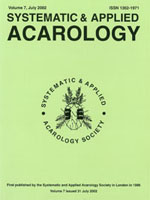This laboratory study examines the life history of Amblyseius cucumeris feeding on Aponychus corpuzae under four constant temperatures. The females of Amblyseius cucumeris required 20.0±0.5 days to complete its development from the egg to adult at 15±1°C, but only 7.7±0.3 days at 30±1°C. The developmental duration of each stage of A. cucumeris decreased with increasing temperature from 15°C to 30°C. The average oviposition period was 22.2±1.6 days, and the fecundity was 28.9±1.9 eggs. The female longevity (egg to death) was 40.6±0.7 days. Latoratory studies of predator : prey numerical responses revealed that at the ratios between 3 : 30 and 9 : 30, predators quickly brought A. corpuzae populations under control and the prey densities began to decrease from the 4th days after predator introduction. The present study shows that A. cucumeris can develop, survive and increase its population when feeding on A. corpuzae and has good potential as a biological control agent of A. corpuzae in moso bamboo forests in Fujian, China.
How to translate text using browser tools
1 July 2003
Studies on the life history of Amblyseius cucumeris (Acari: Phytoseiidae) feeding on Aponychus corpuzae (Acari: Tetranychidae)
Yanxuan Zhang,
Jianzhen Lin,
Zhi-Qiang Zhang,
Yutaka Saito,
Jie Ji
ACCESS THE FULL ARTICLE

Systematic and Applied Acarology
Vol. 8 • No. 1
July 2003
Vol. 8 • No. 1
July 2003
Amblyseius cucumeris (Oudemans)
Aponychus corpuzae (Rimando)
biological control
life history
predator-prey interaction




